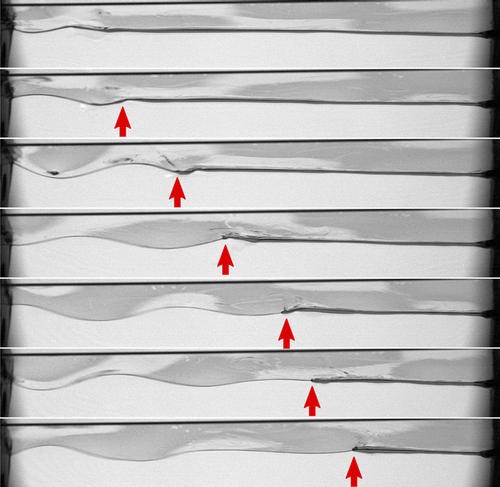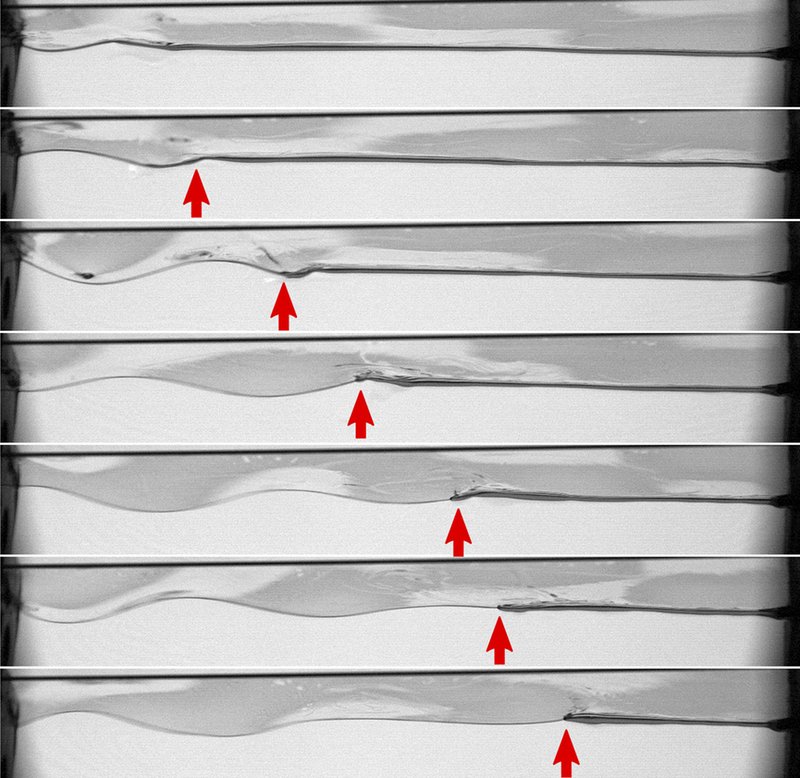Liquid String Vibrations
Foams, like beer and shaving cream, contain liquid microchannels that thread through the network of bubbles. A new experiment involves shaking one end of a single microchannel and recording the vibrational motion. The observations show that this “liquid string” becomes thinner as the amplitude of the oscillation increases. The researches also observed a surprising division of the string into two sections that vibrate differently. The results help explain the way foams react to strong vibrations, which could benefit designs of foam-based shock absorbers.
Foams have unique responses to sound waves and other forms of vibrational energy. Researchers have recently shown that foams behave like acoustic metamaterials that can absorb or reflect sound waves, depending on frequency (see 11 April 2014 Focus story). Engineers have also designed foams that can be sprayed over a bomb or mine to mitigate the blast wave from the explosion. Understanding wave transmission inside a foam is challenging, as there are several components: air bubbles, thin films, and liquid microchannels. A microchannel constitutes the boundary line between three intersecting films, so the motions of the microchannels and films are coupled together in a complex fashion. “Our idea was to begin with a single microchannel and to try to put our finger on one mechanism,” says Christophe Raufaste from Nice Sophia Antipolis University in France. By studying the individual components of foam separately, Raufaste says researchers can develop a fuller understanding of foam wave behavior.
Previous foam experiments have studied low-amplitude vibrations coming from sound waves [1, 2], but it’s unknown what happens as the amplitude increases into the range expected from a blast wave. To explore the high amplitude regime, Raufaste and his colleagues formed a liquid string by dipping a triangular-prism-shaped frame into a soapy liquid. Once removed, three soap films clung to the frame, with a 5-cm-long microchannel in the center where the films met. To fix the initial diameter of the microchannel (about 1 mm) and to offset drainage, the team injected a steady supply of liquid at the right end. At the left end, the team used a thin plate oriented perpendicular to the channel to push up and down on it at a fixed frequency in the range 30–120 Hz.
The setup resembled the classic experiments of the 19th century German physicist Franz Melde, who excited vibrations in ordinary strings and observed the resulting standing waves. Indeed, Raufaste and his colleagues witnessed standing-wave patterns in their liquid string when the plate vibrations had a small amplitude. However, the behavior became much more complex as the researchers slowly ramped up the plate’s driving amplitude. The microchannel’s oscillation amplitude began to vary from one end to the other, affecting its diameter. On the left side (near the plate), the string oscillated with a large amplitude, and its diameter was around 0.1 mm. But moving toward the right, the diameter gradually increased and then suddenly jumped up to about 1 mm. The location of this jump—separating a highly oscillating section from a barely moving section—moved to the right as the driving amplitude increased.
To explain this behavior, the team derived a Bernoulli-like equation for the fluid in the microchannel. On the right side, where the microchannel is more or less stationary, the fluid flows at a steady pace within a tube whose diameter is determined by a balance between outward-pushing fluid pressure and inward-pulling surface tension. However, to the left, the channel is whipped up and down, causing the kinetic energy of the fluid to increase. To conserve energy, the fluid’s pressure in the left portion decreases, which allows surface tension to reduce the diameter.
The team incorporated this amplitude-dependent string diameter into calculations of the coupling between the microchannel and the connected films. This model, which is nonlinear, correctly predicts the sudden change in diameter that was observed. Raufaste imagines that engineers could use this information to control the vibrational response of foams by making the microchannels thicker or thinner.
The research “reveals new, surprising effects on sound wave propagation through liquid foams,” says foam expert Benjamin Dollet from Grenoble Alps University in France. Previous studies had assumed that microchannels had constant size, but the team shows that the liquid string “self-adapts,” Dollet says. Complex fluids researcher Florence Elias of Paris Diderot University says the results provide information on foam vibration at the scale of bubbles, which is essential for ultimately understanding acoustic waves in foam.
This research is published in Physical Review Letters.
–Michael Schirber
Michael Schirber is a Corresponding Editor for Physics Magazine based in Lyon, France.
References
- C. Derec, V. Leroy, D. Kaurin, L. Arbogast, C. Gay, and F. Elias, “Propagation of a Transverse Wave on a Foam Microchannel,” Europhys. Lett. 112, 34004 (2015).
- J. Seiwert, J. Pierre, and B. Dollet, “Coupled Vibrations of a Meniscus and Liquid Films,” J. Fluid Mech. 788, 183 (2015).





